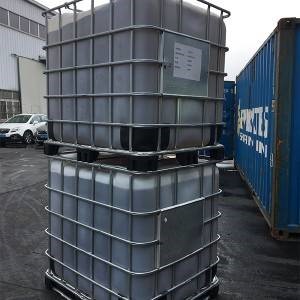Wetting Agent is generally colorless (or light yellow), tasteless, non-toxic, not volatile liquid. Wetting Agent is insoluble in water, methanol, ethylene glycol and 2-ethoxyethanol, and can be miscible with benzene, dimethyl ether, methyl ethyl ketone, carbon tetrachloride or kerosene, slightly soluble in acetone, dioxane, ethanol and butanol. It has low vapor pressure, high flash point and ignition point, and low freezing point. With the different number of chain segments n, the molecular weight increases, so does the viscosity. The siloxane may have a variety of viscosity, from 0.65 cm stoke to millions of cm stoke. If you want to produce low viscosity Wetting Agent, you can use acid clay as a catalyst, and at 180℃ temperature for polymerization, or use sulfuric acid as a catalyst, at low temperature for polymerization, the production of high viscosity Wetting Agent or gunk can be used as an alkaline catalyst.
Wetting Agent has heat resistance, electrical insulation, weather resistance, hydrophobicity, physiological inertia and small surface tension, in addition to low viscosity-temperature coefficient, high resistance to compressibility, some varieties also have radiation resistance performance.
Type: Silicone oil usually refers to linear polysiloxane products kept in liquid state at room temperature. The structural formula is as follows: In the formula, R is alkyl, aryl, R’ is alkyl, aryl, hydrogen, carbon functional group and polyether chain; X is alkyl, aryl, alkenyl, hydrogen, hydroxyl, alkoxy, acetoxy, chlorine v, carbon functional group and polyether chain; n, m=0, 1, 2, 3…
The most commonly used silicone oil, organic groups are all methyl, called methyl silicone oil. Organic groups can also use other organic groups to replace part of the methyl group, in order to improve a certain performance of silicone oil and suitable for a variety of different uses. Other common groups are hydrogen, ethyl, phenyl, chlorophenyl, trifluoropropyl and so on. In recent years, organic modified silicone oil has been developed rapidly, and many organic modified silicone oil with special properties have appeared.
According to the chemical structure, the silicone oil is divided into methyl silicone oil, ethyl silicone oil, phenyl silicone oil, methyl hydrogen silicone oil, methyl chlorophenyl silicone oil, methyl ethoxy silicone oil, methyl trifluoropropyl silicone oil, methyl vinyl silicone oil, methyl hydroxyl silicone oil, ethyl hydrogen silicone oil, hydroxyl hydrogen silicone oil, silicone oil containing cyanide, etc.; From the use, there are damping silicone oil, diffusion pump silicone oil, hydraulic oil, insulation oil, heat transfer oil, brake oil, etc.
Application:
Silicone oil has a very wide range of applications. It is not only used as a special material in aviation, cutting-edge technology and military technology departments, but also used in various sectors of the national economy. Its application scope has been expanded to: construction, electronic and electrical, textile, automobile, machinery, leather and paper making, chemical and light industry, metal and paint, medicine and medical treatment.
The main applications of silicone oil and its derivatives are defilm agent, shock absorber oil, dielectric oil, hydraulic oil, heat transfer oil, diffusion pump oil, defoamer, lubricant, hydrophobic agent, paint additive, polish agent, cosmetic and daily life additives, surfactant, particle and fiber treatment agent, silicone grease, flocculant.
Advantage:
(1) The viscosity performance is the best in the liquid lubricant, and the viscosity changes in the wide temperature are small. Its condensate point is generally less than -50 ° C, and some are up to -70 ° C. It is stored for a long time at low temperature. The appearance and viscosity of its oil products have not changed. It is the basic oil that takes into account the high temperature, low temperature, and wide temperature range.
(2) Excellent thermal oxidation stability, such as thermal decomposition temperature> 300 ° C, small evaporation loss (150 ° C, 30 days, evaporation loss is only 2%), oxidation test (200 ° C, 72H), viscosity and acid value changes Small.
(3) Excellent electrical insulation, volume resistance, etc. In the normal temperature ~ 130 ℃, it does not change (but the oil cannot be water).
(4) It is a non -toxic and low -foam and strong anti -bubble oil, which can be used as a muffler.
(5) Excellent shear stability, which can absorb vibration and prevent vibration transmission.
Shortcoming
(1) The lubrication of silicon oil is not good, especially the lubrication of steel and steel friction.
(2) The thermal expansion coefficient of silicon oil is large (may be over pressure).
(3) Gas solubility is large (difficult to design gas sealing device).
(4) certain hygroscopicity (water performance decreases sharply after the water content is higher than 100 × 10-6).
(5) The surface tension is small (easy to leak from the machine).
Package:1L/IBC,200kg/steel drum, 25kg/plastic drum, 5g/pice. To store in a cool place. to prevent dirct sunlight, non-dangerous goods transportation.
Post time: May-24-2023


